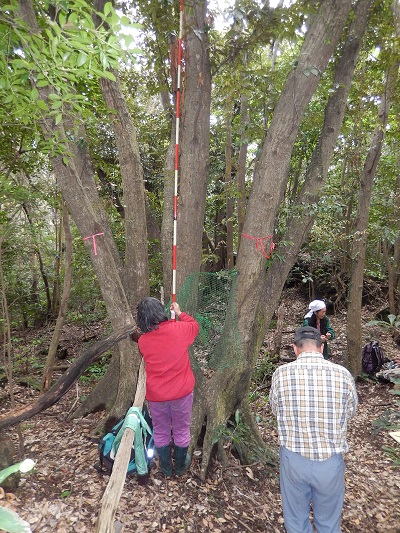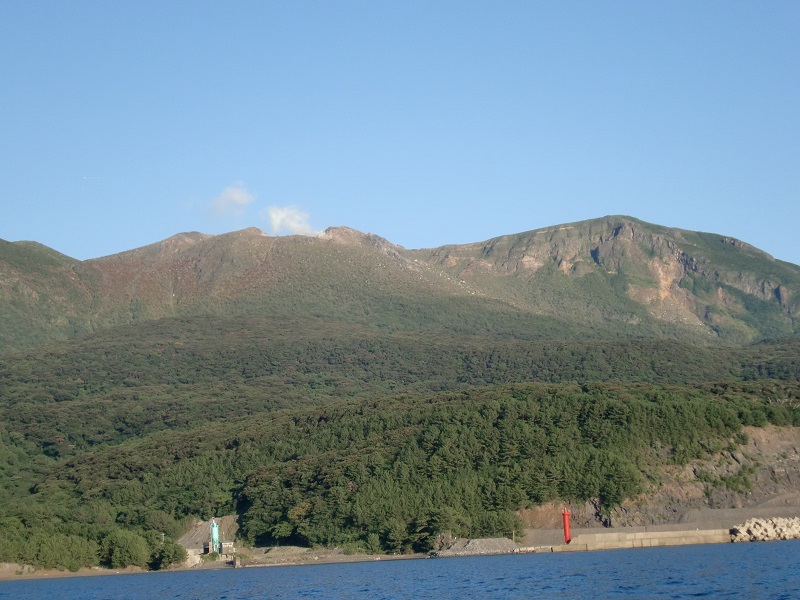travel guide of Kuchino-erabu island

891-4208 Kuchi-Erabu Island, Yakushima-cho
Takaturu-Ran Orchids Erythrorchis altissima
About 30 individuals of Takaturu-Ran (a mycoheterotrophic orchid, Erythrorchis altissima) was found in the forests on Kuchinoerabu-jima.
They are native to Southeast Asia, Ryukyu, Okinawa, Tokara and Satunan Islands. Kuchinoerabu-jima, Yakushima and Tanegashima are the northern limits of their habitats.
Takaturu-ran orchids are now classified as Critically Endangered (IA, CR) on the Ministry of the Environment's Red Data Book of Threatened species.

YOCA (Yakushima Overall Conserving Association) has been engaged in research of Takaturu-ran orchids. Recently, Kuchino-Erabu Senior group joined the YOCA's project together with associate Professor Yuki Tujita of Saga University.
Table Monitoring of Takaturu-ran and other plants(2014)
| Date | Time period | Location | Observations |
| 29June | 14:00-15:15 | West of the old quarry | One individual of Takaturu-ran (Erythrorchis altissima) was in full bloom. |
| 22June | 14:30-16:00 | Mikan-yama hiking trails | (1) confirmed one individual flowering of 20% from 10%. (2) the other individual was state of just before flowering. (3) Mr. G discovered a new individual of Takaturu-ran. |
| 8June | Mikan-yama hiking trails | Takaturu-ran tour was held as a excursion of 2nd International TERUHA forest Conference in Yakushima(2014.6) | |
| 1June | Maeda-Noike hiking trails | Exploration of Takaturu-ran and development of hiking trails. | |
| 22May | 8:00-10:30 | Mikan-yama hiking trails | Found the seed bags (three) on the ground and buried them in soil again. |
| 6May | 1000-1400 | Hiking trails (nemachi→nita→peak526) | (1) Exploration of Takaturu-ran, (2) Development of hiking trails using with GPS. |
| 5May | 930-1700 | Maeda-Noike hiking trails | (1) Exploration of -ran, (2) Development of hiking trails using with GAPS. |
| 4Apr | 1000-1700 | Mazda-Noise hiking trails | (1) Exploration of Takaturu-ran, (2) Development of hiking trails using with GPS. |
| 1Apr | 800-1230 | Mikan-yama hiking trails | (1) Checked the safety of the seed bag. (2) Collected roots of takaturu-ran. (3) Checked the state of a dozen individuals. |
| 31Mar | 1600-1730 | South of Erosion-control dam | Checked three individuals |
| 19Jan | 1400-1530 | Mikan-yama hiking trails | (1) Checked eight individuals. (2) Checked seed bags*. *"Seed bag" was a bag filled with seeds and buried in soil. |
What is Takaturu-ran Orchids?
Takaturu-ran (Erythrorchis altissima), a kind of Orchid vine, is native to evergreen broad-leaved forests. As Takaturu-ran has no leaves, they must get nutrients from wood-rotting fungi. Most of the individuals were found on the tree of Sudajii (Castanopsis sieboldii)*.
According to the YOCA's report, the number of Takaturu-ran found on Tanegashima and Yakushima is less than that of Kuchinoerabu-jima.
*
H.UMATA , S.KANETANI and T.MORI, The habitat and habit of a chlorophyll-free
orchid, Erythrorchis altissima, Acta Phytotax Geobot,45(2), 131−138 (1994)
Takaturu-ran are growing in this Forestry.
Takaturu-ran able to grow up?
What kind of habitats are Takaturu-ran growing in? They are living in deep
and primeval forest where the population of Sudajii(Castanopsis sieboldii Hats.) is rich. When you drive through the island, you can appreciate the forest's
depth. You will find a laurel forest consisting of following trees.
Sudajii (Castanopsis sieboldii Hats.) .
Gajumaru (Chinese Banyan, Ficus microcarpa L.f.)
Akou (Banyan tree, Ficus superba Miq. var. japonica Corner)
Tabunoki (Persea thunbergii Kosterm.)
Hisakaki (Eurya japonica Tunb.)
Hama-hisakaki (Eurya emarginata Mak.)
Moku-tachibana (Ardijia sieboldii Miq.)
Most of the island is covered with evergreen forests.
Forest of Sudajii (Castanopsis sieboldii)
| Volcano |

Kuchinoerabu-jima currently has an active volcano. Mt. Furu-dake and Mt. Shin-dake in the eastern part of the island have fumarolic activity. Visitors can see a dynamic landscapes that can not be found on Yakushima Island.
The highest point on the island is Mt. Shin-dake with a height of 657 meters,
and only the low-land is a slight indentation of the coastline.
The volcano, which had not erupted since 1980, had a new eruption on August 3, 2014, at 12:24 local time.
1 min after the eruption on August 3, 2014.
More details and photos.
The colony of Maruba-satsuki (plant species of azalea) can only be seen around the peaks of mountains affected by volcanic gasses.
Maruba-satsuki
Return to Top